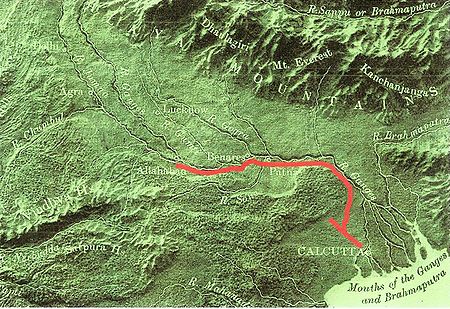
Howrah railway station is a railway station located in the city of Howrah, West Bengal, India. It is the largest and busiest railway complex in India as well as one of the busiest and largest train stations in the world. It is also the oldest surviving railway station complex in India. Howrah is one of six intercity train stations serving the Kolkata metropolitan area, the others being Sealdah, Dankuni, Santragachi, Shalimar and Kolkata railway station.
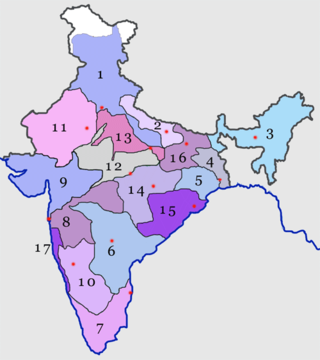
The Eastern Railway is among the 19 zones of the Indian Railways. Its headquarters is at Fairley Place, Kolkata and comprises four divisions: Howrah, Malda, Sealdah, and Asansol. Each division is headed by a Divisional Railway Manager (DRM). The name of the division denotes the name of the city where the divisional headquarters is located. Eastern Railway oversees the largest and second largest rail complexes in the country, Howrah Junction and Sealdah railway station, and also contains the highest number of A1 and A Category Stations like Howrah, Malda Town, Sealdah, Asansol, Kolkata, Durgapur, Barddhaman, Rampurhat Junction, Bhagalpur, Jasidih, Bandel and Naihati. Eastern Railways operates India's oldest train, Kalka Mail.

Kiul Junction railway station, is one of the major railway junctions in Danapur division of East Central Railway. Kiul is connected to metropolitan areas of India, by the Howrah–Delhi main line via Mugalsarai–Patna route which runs along the historic Grand Trunk Road. The Danapur railway division's main line crosses Sahibganj loop line at the Kiul Junction. The main line crosses the Kiul River between Kiul Junction and Lakhisarai Junction. The Gaya–Kiul line also starts from the Kiul Junction.

George Turnbull was the Scottish engineer responsible from 1851 to 1863 for the construction of the first Indian long-distance railway line: Calcutta to Benares up beside the Ganges river, 541 miles, . The main line was later extended to Delhi. He had some 100 British civil engineers and 118,000 Indian workers. All railway lines, engines etc etc were brought from Britain in ships -- most then went in Indian ships up the Ganges river, despite monsoons.

Koilwar Bridge, at Koilwar in Bhojpur spans the Sone river. This 1.44 km long, 2-lane wide rail-cum-road bridge connects Arrah with Patna, the capital of Bihar state in India. The bridge is named after Indian academic and social reformer Prof. Abdul Bari, and is presently the oldest operational railway bridge in India standing since 4 November 1862. It is shown in the 1982 Oscar award winning film Gandhi, directed by Richard Attenborough. From 1862 to 1900, Koilwar bridge remained as the longest river bridge in India.

The Howrah–New Delhi main line is a railway line connecting Delhi and Kolkata cutting across northern India. The 1,531 km (951 mi) railway line was opened to traffic in 1866 with the introduction of the "1 Down/2 Up Mail" train.
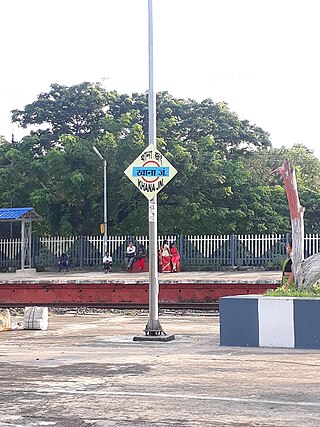
Khana Junction is a railway station in Bardhaman Sadar North subdivision of Purba Bardhaman district in the Indian state of West Bengal.

The Sahibganj loop is a railway line connecting Khana Junction and Kiul Junction. Originally a part of the Howrah–Delhi main line, it was opened to traffic in 1866. With the construction of a shorter railway line for a part of the route, the 403.8 kilometres (250.9 mi) stretch was assigned a separate identity.
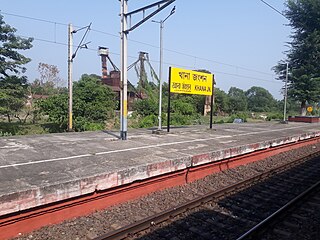
The Bardhaman–Asansol section is a railway line connecting Bardhaman and Asansol. This 106 kilometres (66 mi) track is part of the Howrah–Delhi main line, Howrah–Gaya–Delhi line and Howrah–Allahabad–Mumbai line. It is under the jurisdiction of Eastern Railway, and is connected to the South Eastern Railway through Asansol–Adra line at Asansol Jn and Kalipahari–Damodar connector at Kalipahari.

The Asansol–Gaya section is a railway line connecting Asansol and Gaya in India. This 267-kilometre long (166 mi) track is part of the Grand Chord, Howrah–Gaya–Delhi line and Howrah–Allahabad–Mumbai line. This section includes the NSC Bose Gomoh–Barkakana line. It is under the jurisdiction of Eastern Railway and East Central Railway. The section links to South Eastern Railway through Bokaro Steel City and Adra.

The Howrah–Prayagraj–Mumbai line, is a railway line connecting Kolkata and Mumbai via Prayagraj. The 2,160-kilometre long (1,340 mi) railway line was opened to traffic in 1870. This railway line was 2,146-kilometre long (1,333 mi) until 2004. In 2004 the construction of Indira Sagar Dam submerged the old alignment near Khandwa & a new alignment of 14-kilometre long (8.7 mi) was relaid.

The Asansol–Adra–Tatanagar–Kharagpur line is part of Howrah and eastern India's links with Mumbai and Chennai. It is also a major freight line for transporting iron ore, coal and steel products. This page includes the Adra–Bokaro Steel City branch line, the Adra-Gomoh branch line, the Adra-Dhanbad branch line and Tatanagar–Badampahar branch lines.

Sainthia Junction railway station is one of the oldest stations in India serves Sainthia city of Birbhum district in the Indian state of West Bengal. It is a "NSG-5" category railway station. The railway station is under the administrative control of Howrah division of Eastern Railway. Sainthia Junction comes under the jurisdiction of Sainthia GRP Police Station. There is a total of 54 train arrivals and departures per day happening at this railway station. Sainthia Junction the 3rd busiest railway station in Birbhum district. This railway station is the busiest "NSG-5" category railway station in Howrah division and 6th busiest in all of NSG category railway stations in Howrah division. It also serves as the originating station of 4 important trains. In this station the famous Sainthia train collision took place between Uttar Banga Express and Vananchal Express

Hooghly is a Kolkata Suburban Railway station on the Howrah–Bardhaman main line. It is located in Hooghly district in the Indian state of West Bengal. It serves Hugli-Chuchura and surrounding areas.

Prayagraj Junction, formerly known as Allahabad Junction, is a railway station on the Howrah-Gaya-Delhi line,Howrah–Delhi main line, Prayagraj–Mau–Gorakhpur main line and Howrah–Prayagraj–Mumbai line. It is the headquarters of the North Central Railway zone. It is located in Prayagraj in the Indian state of Uttar Pradesh. It serves Prayagraj and the surrounding areas.
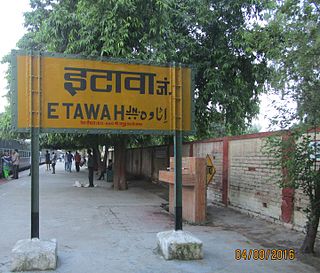
The Kanpur–Delhi section is a railway line connecting Kanpur Central and Delhi. This section includes Agra Chord and Etah link. The main line is part of Howrah–Delhi main line and Howrah–Gaya–Delhi line. The Agra–Delhi chord is part of Delhi–Mumbai line and Delhi–Chennai line.

Bhagalpur Junction railway station, is an A-1 category railway station serving the city of Bhagalpur in the Bhagalpur district of Indian state of Bihar. It comes under jurisdiction of Malda Railway Division of Eastern Railway Zone of Indian Railways. Bhagalpur Railway Station is among the 148 important stations that have been selected for redevelopment with world-class infrastructure having an airport like look. Ministry of Railways has approved its master plan for redevelopment at a cost of 481.60 crores and tender is in process. A new Bhagalpur station will also be built near the bypass at a cost of 200 crores.

The Howrah–Gaya–Delhi is a railway line connecting Howrah and Delhi cutting across Indo-Gangetic Plain and a comparatively small stretch of the line crossing over the Chota Nagpur Plateau. It covers a distance of 1,452 kilometres (902 mi) across, West Bengal, Jharkhand, Bihar, Uttar Pradesh and Delhi. The Grand Chord is a part of this line and as such is referred to by many as Howrah–Delhi line.
The Gaya–Kiul line is a railway line connecting Gaya on the Howrah–Gaya–Delhi line and Kiul on the Howrah–Delhi main line both in the Indian state of Bihar.
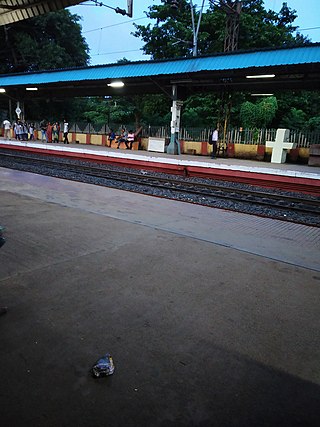
Chunchura railway station is a Kolkata Suburban Railway station on the Howrah–Bardhaman main line. It is located in Hooghly district in the Indian state of West Bengal. It is under the jurisdiction of Eastern Railway zone. Chunchura railway station is a small railway stations of Howrah railway division. It serves Chinsurah and surrounding areas. It is 36 km. from Howrah Station.

